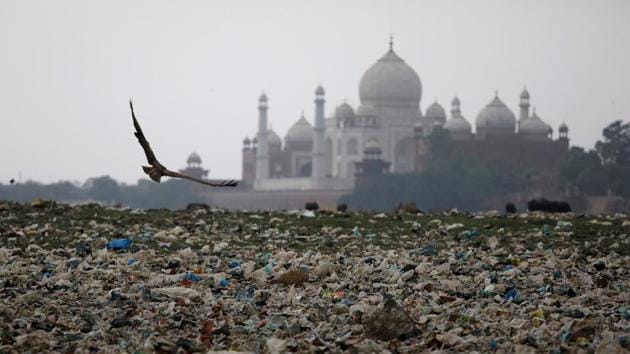A free-flowing Yamuna is critical to the Taj Mahal’s future
Yamuna is an integral part of Taj’s design and there was no anticipation that it would dry or become narrow. But the river has narrowed and it’s polluted. The wooden foundations are likely to become brittle and might disintegrate because, as Venice which is built on a wooden foundation shows, longevity of wood increases when it is submerged in water
A “teardrop on the cheek of time” is how Rabindranath Tagore described the Taj Mahal. For some, “teardrop” represents the tragedy that befell Shah Jahan as he spent his last days in captivity, gazing at the mausoleum and its reflection in the Yamuna. Perhaps, the Mughal emperor’s words — “the sight of this mansion creates sorrowing sighs and makes sun and moon shed tears from their eyes” — captured his love for Mumtaz Mahal , but reading those lines today makes me think that the tears are trickling down a sluggishly flowing Yamuna, carrying the waste left by humans.

When Shah Jahan eternalised his love for Mumtaz, he must have believed that the river would be flowing forever. But for the lack of foresight on that one issue, his decisions were perfect. The choice of a site near a sharp bend in the river was for aesthetics and to reduce scouring by erosion. There was no solid ground on which the foundation could be built. So they used a well foundation, an engineering practice using deep wells to lower the water table and filling them with rocks and mortar. Finally they were capped with wooden, boxlike structures on which the mausoleum was constructed. Little is known about the Taj’s foundation, and these details have been dug up by SC Handa, a former professor at IIT, Roorkee.
The Yamuna is an integral part of the Taj’s design and there was no anticipation that it would dry or become narrow. But the river has narrowed and it is polluted. The wooden foundations are likely to become brittle and might disintegrate because, as Venice, built on a wooden foundation, shows, longevity of wood increases when it is submerged in water. When the wood is not exposed to oxygen there are no microorganisms to promote decay. A dry Yamuna could promote disintegration of the wooden foundations, the corrosive effect of the polluted water adding to the decay. Thus, to retain the structural integrity of the Taj Mahal, a free-flowing Yamuna in its original form is a must.
We should feel proud and energised about river restorations because rivers have always been a part of our culture. We worship rivers, perform rituals, cremate the dead and offer prayers on their banks. Little surprise then that the premises of the Sarayu river, on the banks of which stands Ayodhya, is being chosen as the site for the proposed statue of Ram.
We can create large statues, but can we restore the choked and dying river?
The once mighty Sarayu, was about 1.5 kilometre-wide; today, it’s just 30-40 metres wide and is polluted. It is reported that the visionaries of the statue project plan to divert the flow of the Sarayu so as to touch the feet of the Lord at all times. But the rate at which these rivers are declining, how long would they last? Would Ram like the feel of polluted water flowing over his feet, day and night? More than 300 years ago, the builders of the Taj could not have anticipated the drastic transformations that we are now seeing.
Kusala Rajendran is professor, Centre for Earth Sciences, Indian Institute of Science, Bengaluru
The views expressed are personal






